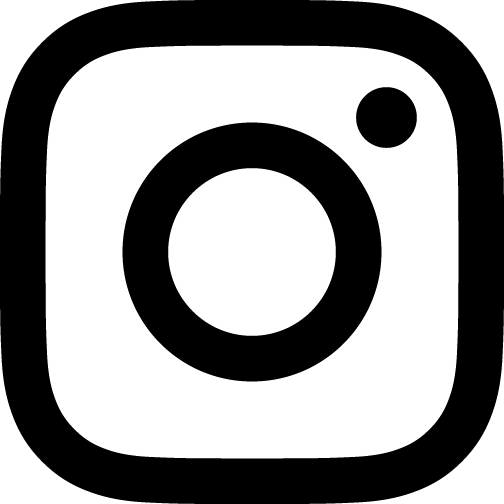Activities
Laboratorium organizes workshops, lectures, and participates in the academic program of KASK in the topics as colors, biomaterials, Art+ Science, and DIYbio. Here, you can find info on previous activities and a list of upcoming events.
ETHO New Material Practice in Biolabs
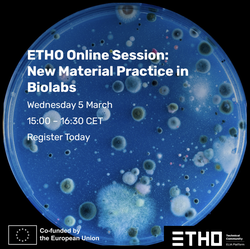
Laboratorium will participate in the ETHO Online Session: New Material Practice in Biolabs.
How are pioneering art academies redefining material practice through (bio)-labs? Our upcoming #ETHO Online Session will explore how these innovative spaces are shaping new ways of making, learning, and researching with living and biological systems.
Join us online on Wednesday, 5 March 2025, at 🕒 15:00 – 16:30 CET.
The 6th Interantional Symposium by the International Research Center for Color Science and Art
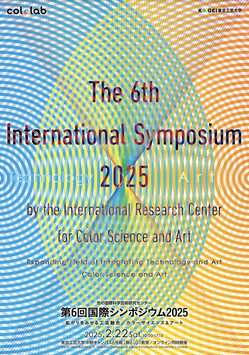
The 22nd of February we will present our resarch project "Ecology of colour" at the 6th International Symposium by the International Research Center for Color Science and Art of Tokyo Polytechnic University.
Visit Holography collection ULiege
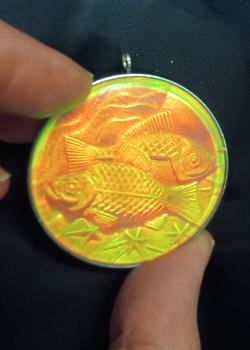
During the Master Seminar "Living Colours" we had the opportunity to visit the holography collection of Liège University. Our guide, Professor Hervé Caps gave us an introduction on laser holography and the history of the biggest holographic lab existing in Belgium.
Master Seminar Living colours 2024
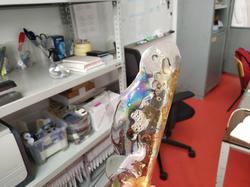
As an artist and designer, colour is a constant consideration. You must deal with material selection, application methods, colour combinations, and the role of light, often seeking inspiration from the perfect palettes found in nature. In this seminar, we will explore colour from various perspectives, including its role in nature, physical and chemical properties, the influence of light, or human colour perception. Understanding the principles and dynamics of colours opens new possibilities of creation by considering colour not only as a predefined material to apply on a surface but as something alive, fluctuant, variable, and organic to create different sensory experiences. What are the dynamics of colour in nature? What are the potential applications of colour dynamics in art and design? Can we think about colour as something immaterial? What is the ecological impact of our decisions regarding colour? Starting from a scientific approach, each session explores the basic principles of colour and its potential for artistic creation. Every session will be paired with a practical application, using diverse media such as textiles, paper, plastic, and photography to achieve this.
Essential readings LABORATORIUM

Essential Reading is a project that aims to enlarge, diversify and enrich Kunstenbibliotheek’s book collection. Which books are, today, really indispensable for an art library? Guests of Essential Reading bring together and present in the library the books they consider most valuable in their life and work. Photo credits Sarah van Looy More info
Les Marées by Amandine David
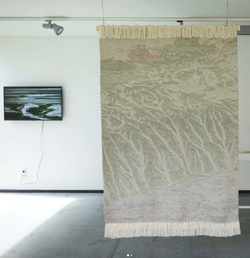
Every summer, green algae cover the beaches of Brittany. Every morning, human workers and backhoe loaders clean it. The accumulation of algae on Breton coasts is generated by industrial farming that reject big quantities of nitrates in soils and rivers. The cleaning of beaches, done daily during summer, reduces the risk hydrogen sulphide poisoning created by the decomposition of algae.
Cleaning algae becomes also a way to make questions disappear from the landscapes. Instead of treating solely visible symptoms, how could this pollution be stopped? How can we reinvent the relation between our agricultural model and our environment?
From 10th of June till 14th of June Laboratorium will show its most recent collaboration with Amandine David. You can find the small expo at the Glazen Gang on campus Bijloke. More infoLASER Talks Brussels, Light, Color and Matter

LABORATORIUM participated in the LASER Talks Brussels: Light, Color and Matter. The topic "Light, Color, and Matter" is an exploration into the dynamic relationship between perception and materiality. It encompasses a broad spectrum of topics, including the study of vision in various organisms, from humans to animals and insects, the fundamental properties of electromagnetic radiation, the behavior of light waves, and the interaction of light with matter. Exploring texture, transparency, reflectivity, and other material qualities enriches our understanding of how light interacts with surfaces and shapes our perception of the world. Watch the video More info
Matérialités, heuristique et écologie de la recherche
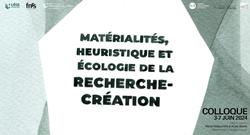
This conference examined, from an aesthetic point of view, the tight links between research and creation by focusing on the concrete modalities of the construction of knowledge. Under the title Structural colours. A research journey from nature to materiality we presented the project done in collaboration with Ann Veronica Janssens. More info
FTI expo
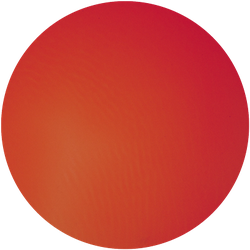
During Flanders Technology & Innovation Ghent the work Petrilogy,a collabortion between Elias Heuninck and LABORATORIUM, will be exhibited in the expo.
The Winter Circus occupies a unique place in Ghent - both in the city's skyline and history. In 2024, tech start-ups will take up residence there, in the place where acrobats used to skim over the heads of elephants. But not before The Expo by ArcelorMittal takes visitors on a ride along all floors and corners of the former circus building (and old-timer cemetery). For the first and last time.
Visit on the 16th and 17th of March.
Kleur Bekennen at FTI
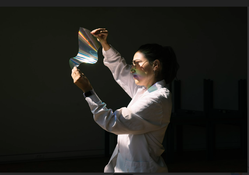
The textile industry is one of the most polluting industries in the world because of synthetic textile dyes. Can designers and researchers turn the tide with colourful alternatives? The project "A confession of Colour" leaded by the photographer Sarah Van Looy and journalist Sarah Vandoorne investigate this matter. In the expo you will discover black and white portraits of designers on organic cotton, colored with their own sustainable dyeing techniques. Progressive and simple plant-based techniques are used: from algae to apple peels, from flowers to bacteria.
Columbia College Lecture
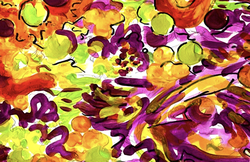
During a visit to Chicago we were invited by the artist and educator Friedhard Kiekeben to give a lecture to his students from Columbia College about natural coloring and the collaboration done together within the framework of Safer Painting. Friedhard is globally known for his research on not toxic methods to be applied in the arts. His research can be found in the website Safer Painting.
SAIC visit

During the week of the 25th of February, LABORATORIUM had the opportunity to visit the School of Arts of the Art Institute of Chicago . During this visit, hosted by the artist Jan Tichy, we visited the biolab, discussed the application of structural colours within the arts and met with grad students whose projects were in the field of art and science.
Master in Design through New Materials 2024

Over the course of 3 days in the Master in Design through New Materials, we brought vibrant colours to life through the use of pigments and structures. Our pigmented colour palette came from microorganisms, specifically bacteria and microalgae, and plants. When it comes to utilizing bacteria, we employed a in vivo approach to dye textiles by controlling the oxygen. In the case of microalgae and plants, pigments were extracted from the organisms itself. We applied the pigments on different substrate, using their light sensitivity to create different hues and prints. Additionally, we explored the realm of structural colouration by the application of diffraction grids on various surfaces. More info
De+Humans
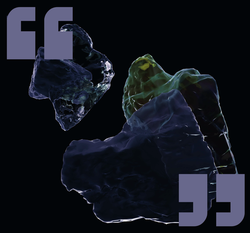
Built up on the border between design, technology and nature, in a philosophical perspective linked to multispecies coexistence and environmental ecosystems, the artefacts on display (objects, contemporary jewels and video installations) were not constituted as passive elements of a theoretical discourse but activate a reflective process through which to live experiences of awareness oriented towards a new coexistence between human and non-human beings.
Pieces of the project Mirrors were exhibited in collaboration with Officina Vanvitelli and the professor Chiara Scarpitti.
Welcome to the two sides of life
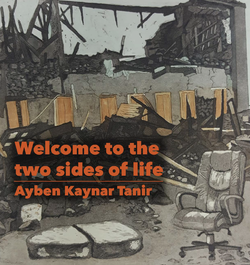
Dr. Ayben Kaynar Tanır presents in the exhibition “Two Faces of Life” her artworks, created with the non-toxic printmaking techniques she learned under the supervision of professor Marnix Everaert at the Academy of Visual Arts Ghent and some of the pigments from LABORATORIUM. Using images such as stones, rocks, tree roots and chair in her artworks, the artist critically questions the earthquakes in Turkey that occurred on February 6, 2023. Dr. Ayben Kaynar Tanır was a guest researcher at KASK & Conservatorium and the Academy of Visual Arts Ghent through TÜBİTAK 2219-International Postdoctoral Research Fellowship Programme. Her postdoctoral research is titled Research and Application of Methods and Techniques fort he Establishment of a Non-Toxic Printmaking Studio at the Faculty of Fine Arts of Ankara University: A Case Study.
Structural colours in the arts
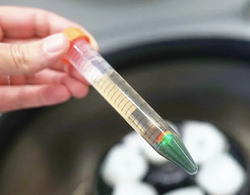
LABORATORIUM did an introduction to the use of structural colours in art and design for Panoptès Foundation. During the lecture the work done in collaboration with Ann Veronica Janssend was presented.
Animal bodies
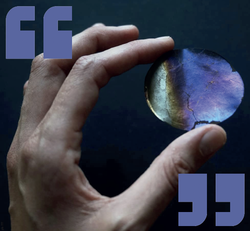
Within the project De+HUMANS, from the University of Studies of Campania “Luigi Vanvitelli”, the research Ecology of Colour and the collaboration with the designer Chiara Scarpitti was publicly presented.
Master in Design through New Materials 2023
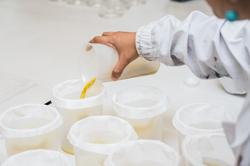
Module on sustainable colour production run by Heleen Sintobin and Camille Wouterson within the Master Design through New Materials.
Project Week Colour Activism

Ben jij iemand die gefascineerd is door kleuren, biologie/wetenschap, ecologie, research en duurzaamheid dan is dit project van de projectweek misschien wel iets voor jou. Wij (Heleen Sintobin, Liselotte van Daele en Camille Wouterson) willen jullie graag uitnodigen om vanuit een eigen intrinsieke interesse/motivatie/passie… deel te nemen aan 3 dagen van Colour activism.
Vandaag de dag kunnen we niet om de klimaatverandering heen. De zichtbare gevolgen hebben een grote impact op het dagelijkse leven van mensen overal ter wereld. Hoe ga jij hiermee (climate anxiety)? Hoe kan je andere bewust maken van de klimaattransitie om ons heen. In deze projectweek focussen we op klimaatactivisme en gaan we aan de slag met kleur en printtechnieken?
Deze projectweek is een samenwerking met Laboratorium, het biolab van KASK dat zich specialiseert in duurzame kleurenproductie en grafiek waarbinnen we experimenteren met verschillende druktechnieken. (zeefdruk, lasercutter, vinyl…) Dit doen we op een duurzame manier met algenpigmenten.
KIKK
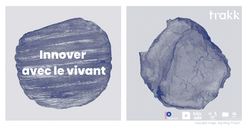
On 23 September, the KIKK, TRAKK and Le Pavillon teams invite you to TRAKK for an afternoon of inspiring talks on the theme of biomimicry.
Our goal is to raise awareness of the approach and its application at different scales in different sectors: scale of bio-inspired materials, scale of bio-inspired goods (products and services), scale of bio-inspired habitats, scale of bio-inspired cities and territories
entre le crépuscule et le ciel, collaboration with Ann Veronica Janssens at Collection Lambert
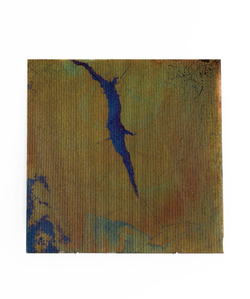
“Comment montrer, sans les trahir, les choses simples dessinées entre le crépuscule et le ciel ?” René Char
Au premier étage de l’hôtel de Montfaucon, Ann Veronica Janssens a choisi de découvrir la totalité des vingt-six fenêtres qui rythment le parcours du visiteur, de sorte que la lumière traverse l’espace de part en part. À travers une série de sculptures, installations et peintures au sol dans lesquelles la lumière s’éprouve sous différents états — réfléchie, absorbée, capturée, transformée — de situations où nos corps et nos esprits affectés naviguent en permanence entre contemplation et immersion, Ann Veronica Janssens nous invite à une expérience où la tension entre dissolution et résolution se réinvente indéfiniment, à nos côtés et avec nous.
Exhibition dates: 2nd July to 9th October 2022
Presentation of the collaboration with Ann Veronica Janssens on Strucural color.
Photo: The structural color project, Blaise Adilon.
Future Materials Encounter at Jan Van Eyck Academie
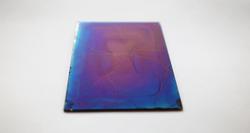
Future Materials Encounter #6: Blue Elf Cup by Liene Kazaka on 25th June 2022
A journey into the colorful world of fungi and microorganisms with Liene Kazaka, in conversation with Heleen Sintobin.
Liene will share her experience about the Myco Colour project, telling us how she became friends with a blue mushroom and why this type of interaction is important for creating more sustainable practices. Together with Liene and Heleen, we will discuss what we know and don't know about mushrooms, as well as the basic principles of working with them.
Laboratorium at BIOTOPIA
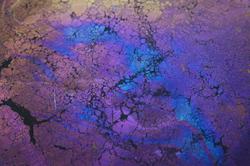
Biotopia, a contraction of Biotope and Utopia, plunges us into the universe of living beings that inhabit our planet. The exhibition brings together nearly 30 artists, designers, researchers, women, men and people who question the central position of humans in the world. For the exhibition Biotopia, Laboratorium presents the ongoing project ‘Ecology of Colour’ by showing a colour palette embodied in a collection of porcelain pieces coloured by melanin nanostructures in combination with insects such as beetles and butterflies that naturally present these colours.
From the 18th of June to 27th of November 2022.
Chaire Beaute

The Beauty Chair welcomes Ann Veronica Janssens, María Boto Ordóñez, Heleen Sintobin and Liliana D'Alba for an interactive conference. This evening is part of the "Structural colors" project, winner of the call for collective and transdisciplinary projects of the Beauty Chair, and will report on the preliminary results of their work carried out since January 2021.
Laboratorium at Radio Nacional de España
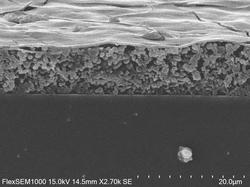
En nuestra cita con los científicos expatriados, viajamos a Bélgica, donde trabaja como investigadora María Boto Ordoñez, licenciada en Tecnología de Alimentos por la Universidad de León. Esta científica trabaja desde 2016 como responsable del Laboratorium, el laboratorio experimental de arte, diseño y biotecnología de la Universidad de Gante. Se dedica a la investigación de materiales y metodologías sostenibles en relación al uso del color en el campo del arte y el diseño. Investiga con los pigmentos de las microalgas y con revestimientos en nanoestructuras basados en la melanina.
Nos acompaña como siempre nuestro colaborador, Eduardo Oliver, miembro de Raicex, y jefe de grupo en el Centro de Investigaciones Biológicas Margarita Salas del CSIC, el Consejo Superior de Investigaciones Científicas.
Rivieren lijden onder kleurrijke mode, dus biokleur moet helpen
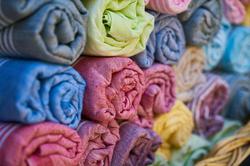
Article at NOS news on textile coloring by the journalist Susan Sjouwerman.
Flanders bio. The art of biotech.
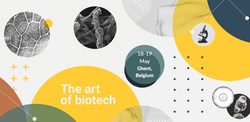
Lecture on transdisciplinary research done at Laboratorium for the conference "Knowledge for growth: The art of biotech"
Kleur bekennen
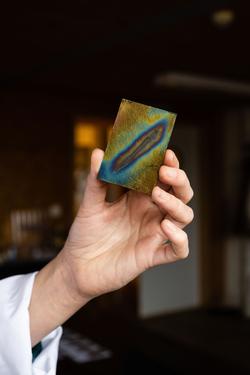
In de kledingketen is geen enkele schakel zo vervuilend als textielverven. Kunnen ontwerpers en onderzoekers het tij keren met kleurrijke alternatieven?
Participation in the European project A confession of color/Kleur bekennen by Sarah Vandoorne and Sarah Van Looy.
Text by Sarah Vandoorne Text by Sarah Vandoorne Images by Sarah Van Looy
Design Festival Ghent: Algae, Living Colours
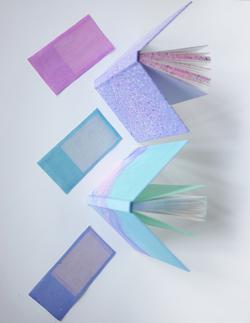
A color spectrum determined by time. Laboratorium experimented with ink from algae on textile, paper and PLA, then exposed them to a weather room with UV light and humidity. Exhibited at Industrie Musuem.
Supported by KASK & Conservatorium (HOGENT - Howest) + UGent
Design Festival Ghent: Structural Colours

In terms of climate impact, the dyeing industry has quite a dark edge. Laboratorium.bio offers alternative methods, such as using nanostructures (as found in peacock feathers) or microalgae that detect pigments in wastewater. Exhibited at Design Museum.
Supported by KASK & Conservatorium (HOGENT - Howest) + UGent
Design Festival Ghent: Wastewater
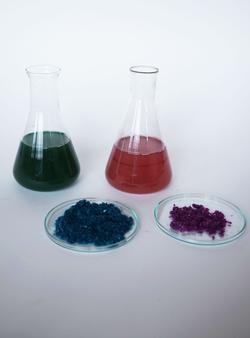
Let the ink flow? Let the ink grow! Laboratorium grows microalgae in industrial wastewater that both purify the water and produce pigment. Exhibited at Design Museum.
Supported by KASK & Conservatorium (HOGENT - Howest) + UGent
Laboratorium at ONRUST
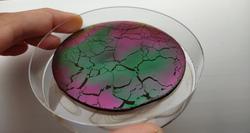
Een ecologie van kleur
Het Color BioLab is al lang geen onbekende meer, ook niet voor de jury van de Henry Van De Velde Award, die het project in de categorie Design Research tot winnaar uitriep.
Het Color BioLab is een geesteskind van designer Heleen Sintobin en wetenschapper María Boto Ordóñez. Gedreven door de nefaste milieu-impact van de kleurindustrie gaat het duo op zoek naar ecologische alternatieven en vormgeeflijke toepassingen. Daarvoor schakelden ze in eerste instantie de hulp in van onze vrienden de microalgen. Lieverdjes met even kleurrijke namen als chlorella vulgaris en haematococcus pluvialis werden losgelaten op vervuild water, waar ze onder wel bepaalde omstandigheden pigmenten vormden. Eenmaal onttrokken aan de biomassa bleken de kleurstoffen inzetbaar in diverse soorten inkt. In een later stadium kwamen ook bacteriën, schimmels en zelfs een aantal planten een handje (eiwitje?) toesteken.
Het onderzoek is ondertussen aan een tweede termijn toe. De microalgen en co doen nog steeds hun ding, maar moeten de aandacht delen met een nieuwe focus. Kleur doet zich namelijk niet enkel voor als pigment. Je kan het ook opvatten als een meer dynamische manifestatie van licht dat, afhankelijk van de invalshoek, op verschillende manieren door een bepaalde structuur reist. Licht is immers geen massief ding, maar een spectrum van golflengtes, die alle anders afbuigen op materiële obstakels en daardoor de samenstelling van het licht veranderen; de kleur dus.
TEKST: Regis Dragonetti
Naturlijke kleuren at Feeling wonen
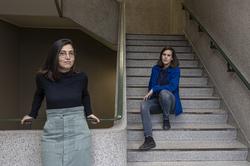
Kleuren die verdampen, als getuigen van de tijd die vervliegt. Of het tegenovergestelde: kleuren die al miljoenen jaren ‘ingebakken’ zitten in een materiaal… Maria Boto en Heleen Sintobin van designstudio Laboratium zoeken aan de hand van biotechnologische technieken naar nieuwe manieren om kleuren te maken en toe te passen. Zullen we straks in staat zijn om het schitterende kleurenpalet van algen, vlinders en dinosaurusveren te produceren?
TEKST JEAN-MICHEL LECLERCQ
FOTO KAATJE VERSCHOREN
Laboratorium at IMAL
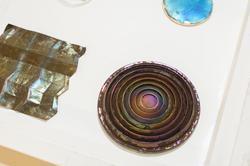
Laboratorium presents at IMAL a serie of projects in collaboration withFORMLAB within the project Tools for Things and Ideas .
Tools for Things and Ideas is a 3-year long research project initiated by Jerry Galle and Elias Heuninck at KASK HoGent (FormLab) and supported by School of Arts, Ghent. It combines a collective of artists, biologists, theoreticians and makers dedicated to enriching the public domain through the research and development of 3D technologies and media. This exhibition presents some of the outcomes of the project.
Henry van de Velde Award

We are happy to announce that we are one of the winner in the category Henry van de Velde award in the category Design Research.
De grote verspreiding van kleur in onze dagelijkse omgeving kan een idee geven van de omvang van de kleurenindustrie. Om deze kleurrijke wereld uit de natuur te genereren is exploitatie nodig. Laboratorium, een experimenteel biolab voor kunst, design en biotechnologie van KASK & Conservatorium, bevraagt milieuvraagstukken en contextualiseert kleur in hedendaagse kunst en design. Dit onderzoek identificeert de milieu-impact van de kleurenindustrie en creëert de verschuiving naar een duurzame benadering van kleur.In het onderzoek Ecology of Colours van wetenschapper Maria Boto en designer Heleen Sintobin staan nieuwe applicaties en technieken binnen traditionele kleurproductie centraal. Ecology of colour ontwikkelt enerzijds duurzame pigmenten afkomstig uit microalgen en past ze toe op verschillende materialen (papier, textiel, bioplastiek) en via verschillende technieken (zeefdruk, digitaal printen, schilderen, 3D printen). Anderzijds analyseert Ecology of colour structurele kleuren die men in de natuur terugvindt. Structurele kleuren worden verkregen door biologische nanostructuren die met licht kunnen interfereren. Deze structuren zijn vaak opgebouwd uit eenvoudige biologische bouwstenen, zoals cellulose, chitine, keratine en melanine. Het zijn biomaterialen die in de natuur veel voorkomen,biologisch afbreekbaar en niet giftig zijn. Met behulp van nanotechnologie kweekt Laboratorium een ecologisch en duurzaam kleurenpalet van structurele kleuren. Laboratorium, een experimenteel biolab voor kunst, design en biotechnologie van KASK & Conservatorium, de school of arts van HOGENT en Howest in Gent is een interdisciplinaire onderzoeksplek waar men bruggen slaat tussen wetenschap, technologie, kunsten en ontwerp.
Henry van de Velde award voting
Second Edition Master Living Colors
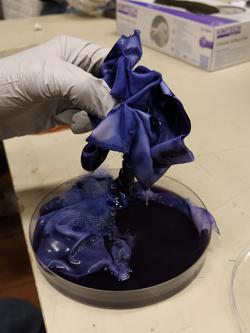
Second edition of the Master Living Colors
Color has always been evaluated on its stability. In the past, numerous books explained the secrets to make a good color. Development of synthetic colors solved this problem, disconnecting color from nature and ignoring its living characteristics. This approach is still present today. Approaching color from a holistic perspective from growing, feeding, cleaning and extracting pigments to the intimate process of finding and applying the right color, challenges designers and artists to question their relation with materials existing in nature, promoting an attitude of a craftsperson working at the service of the material and showing its full potential. Moreover, understanding the dynamics of colors opens new possibilities of creation, by considering color not only as a predefined material to apply on a surface but as something alive, fluctuant, variable, organic to create different sensorial experiences. What are the dynamics of color in nature? What are the potential applications of color dynamics in art and design? Can we think about color as a raw natural evolving material? Can we perceive time through living colors? How can we learn from nature by recreating natural structures on a different scale? During this seminar, theoretical presentations were accompanied by hands-on experiments with coloring materials and its application in different mediums.
Las Cosas at Zulo
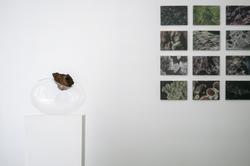
Las Cosas es un proyecto artístico que la arquitecta paisajista Saray Ossorio y el artista Carlos Álvarez hicieron para el Cabildo de Lanzarote con motivo de los cien años del nacimiento de César Manrique. Y del que ahora se muestra una selección de piezas en Zulo. El proyecto reinterpreta aspectos reconocibles de la obra de César, como la relación con el paisaje y la arquitectura vernácula de Lanzarote, pero también a otros aspectos sociales, materiales y espaciales menos tangibles. No se pretende producir piezas que pudieran pasar desapercibidas entre su producción, sino crear una colección de objetos que en su conjunto conformen una interpretación contemporánea – una de las muchas posibles – sobre su labor artística, siempre con la condición de producir en Lanzarote, física y conceptualmente.
Los fragmentos del paisaje En colaboración con la investigadora María Boto, Laboratorium, Evolution And Optics Of Nanostructures, - University of Ghent, hemos mirado algunos de los elementos que componen el paisaje de la isla - tales como el liquen, la cal, la olivina o el picón - a través de un microscopio. Una vez descompuesto y ampliado el paisaje, lo recomponemos en un nuevo conjunto, obteniendo una visión en la que a pesar del cambio de escala se conserva la emoción estética original.
Biologic Art
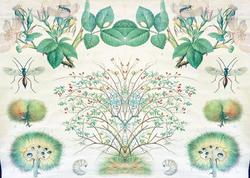
Del 12 al 16 de julio de 2021 la Universidad de León oferta un curso de verano en colaboración con diferentes instituciones de Arte de la provincia para explorar la relación entre Arte y Ciencia y cómo ésta está más viva que nunca, aquí y ahora.
Este curso surge para dar respuesta a las inquietudes relacionadas con ambas disciplinas y cómo su relación se está materializando en el momento actual, debido a la confluencia que está sucediendo en León de una serie de iniciativas que surgen de la mano de personas comprometidas en ello. De hecho, la biología y el arte son en este momento una mezcla tan efervescente en esta ciudad, que el discurso se ha generado de manera natural y espontánea, como toda unión biológica duradera.
El recorrido se inicia con una visión de esta relación desde los inicios de la misma, tratando de manera práctica aspectos como la ilustración botánica o cómo plantearse un proyecto de ilustración científica. Conoceremos diferentes iniciativas de la mano de sus creadores, impulsores o colaboradores, que tratarán la relación del arte con las plantas, la naturaleza, los animales extintos o los laboratorios de biología. Además, visitaremos exposiciones y descubriremos de la mano de los curadores y comisarios la parte oculta de las salas de exposición, las colecciones biológicas y los museos.
Todo esto lo haremos de la mano de la Fundación Cerezales Antonino y Cinia, del MUSAC, de la Escuela de Arte y Superior de Conservación y Restauración de Bienes Culturales de León.
COLORS, ETC.
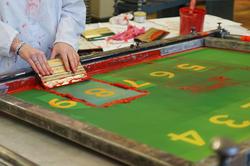
Fading time through colour
The history of colours is the story of the human being trying to appropriate the beauty of nature. From the most basic materials to the current synthetic pigments, all seek to reproduce the experience of the world that surrounds us, appealing to our perception, emotions and previous bodily experiences. A common search developed by artists, alchemists and scientists.
In Laboratorium, the experimental lab for art/design and biotechnology at KASK / School of Arts Ghent, colour is the main research line. From the biolab, we look for new applications of traditional colouring materials as plants or minerals, new colouring sources as microalgae, bacteria or fungi, and new understandings of what a colour can be within the field of art and design.
For this exhibition Laboratorium explores the potential of living inks extracted from micro alga. Once applied on textile or paper the ink is sensitive to UV light and starts to fade, resulting in disappearance. Experience the real-time fading of the calendar as the exhibition days pass by.
Colour code: Dunaliella Salina: orange Arthrospira: blue and green Porphyridium purpureum: pink
Colour Day
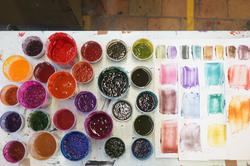
On March 21st 2021, ICA-Belgium, along with many other countries celebrates International Colour Day (ICD). ICD celebrations aim to develop awareness of the importance of colour phenomena and culture in the broad domains of Art and the Humanities, Science, and Technology. ICA-Belgium invites you to join the ICD festive virtual gathering with several guest speakers.
María Boto & Heleen Sintobin will join us with a talk about Ecology of Color. Research journey from nature to materiality. In living beings, colors come from pigments and structures. This research aims to become a bridge between nature and design by dissecting this bases of color generation and translating them into an applicable and sustainable material.
BIOLAB WEEK BIOFRICTION
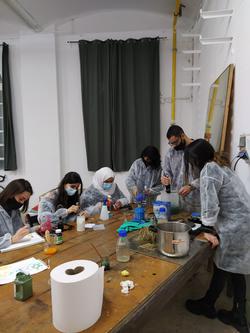
From the 15th to the 19th of March, Elisava’s Master in Design through New Materials and Hangar presented the Biolab week, a week of conferences and workshops on bio materials hosted in the framework of Biofriction.
From the 16th to the 19th of March, Maria Boto, moderated a workshop where 18 students and 4 artists and biologists worked on the topic of color field from different perspectives: from sustainable production and application, to the use of color as a common language between art and science. Starting from traditional coloring, to living organisms or waste, the workshop aimed to reflect about the possibilities of new coloring sources, and the implications involved. During the workshop, participants week obtained color from algae, fungi and bacteria to dissect the bases of color generation and translate them into an applicable and sustainable material.
BioLab Conference

On Monday, March 15 at 6 pm, Elisava Research and the European project Biofriction present the Biolab Conference, a lecture organized within the framework of Elisava’s BioLab Week and the Master in Design through New Materials.
Maria Boto (The Colour Biolab, Hogent); Juan Crespo (Elisava Research BioLab) and Laura Benítez (director of the Biofriction project, led by Hangar) will address topics such as: ‘Ecology of color. A research journey from nature to materiality’, ‘Growing Engineering & Design (and thus, bio)’, and ‘Biofriction: where art and biology meet’. There will be a final debate hosted by Laura Clèries from Elisava Research.
The event will be broadcast in streaming format from Hangar.
Master Living Colors
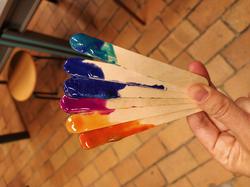
Color has always been evaluated on its stability. In the past, numerous books explained the secrets to make a good color. Development of synthetic colors solved this problem, disconnecting color from nature and ignoring its living characteristics. This approach is still present today. Approaching color from a holistic perspective from growing, feeding, cleaning and extracting pigments to the intimate process of finding and applying the right color, challenges designers and artists to question their relation with materials existing in nature, promoting an attitude of a craftsperson working at the service of the material and showing its full potential. Moreover, understanding the dynamics of colors opens new possibilities of creation, by considering color not only as a predefined material to apply on a surface but as something alive, fluctuant, variable, organic to create different sensorial experiences. What are the dynamics of color in nature? What are the potential applications of color dynamics in art and design? Can we think about color as a raw natural evolving material? Can we perceive time through living colors? How can we learn from nature by recreating natural structures on a different scale? During this seminar, theoretical presentations were accompanied by hands-on experiments with coloring materials and its application in different mediums.
Ciencia con Alma

Ciencia con Alma es un proyecto radiofónico concebido por Radio Alma y por la Consejería Cultural y Científica y que consiste en la elaboración de un ciclo de 10 podcasts sobre distintos temas de actualidad y de la programación de diplomacia y difusión de la Embajada de España en el Reino de Bélgica.
Se trata de entrevistas a científicos e innovadores de habla hispana que viven en Bélgica o que colaboran con contrapartes belgas. Es una iniciativa del programa de Diplomacia Científica, Tecnológica y de Innovación de la Embajada de España en el Reino de Bélgica y se integra dentro del sello #SPreadScience (Spain Spreads Science), que tiene como objetivo acercar las CTI a todos los públicos, fomentando su comprensión como motores del desarrollo social y económico sostenible a través del pensamiento crítico.
Kleurrijke wetenschapsters ELLA

Het geheime leven van kleurrijke wetenschapsters en kunstenaressen. Met ons recente project willen we (verhalen van) straffe vrouwen in STEAM die onze diverse samenleving weerspiegelen in de kijker zetten. Maar ook willen we verwezenlijken dat STEAM-studies even open en toegankelijk zijn voor meisjes als voor jongens uit kwetsbare groepen met een migratieachtergrond.
Best Microalgae Award 2020
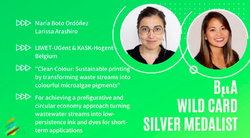
In collaboration with Larissa Arashiro (UGent) we obtained the Best Microalgae Awards 2020 Wild Card Category Silver Medallist with the project Clean Colour: Sustainable printing by transforming waste streams into colourful microalgae pigments, materializing a circular economy approach turning wastewater streams into low-persistence ink and dyes for short-term applications.
Lecture at the Tecnologico de Monterey

Lecture on scientific career development from science to art to students of the multicultural highschool at the Tecnológico de Monterey (Mexico).
Design dialogues x Colour
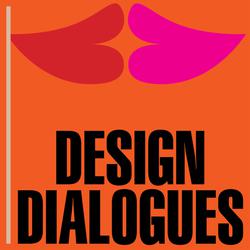
Wat is de invloed van kleur op design, en vice versa? Wat kan kleur betekenen? En hoe ziet de toekomst van kleur en kleurgebruik eruit? Deze lezing, georganiseerd in het kader van Kleureyck, de expo in Design Museum Gent over kleur in hedendaags design, gaat dieper in op deze vragen. Vertrekkend vanuit hun eigen onderzoek en praktijk geven María Boto Ordóñez, die een van de bezielers is van The Color Biolab aan KASK & Conservatorium, en het Nederlandse design duo Atelier NL inzicht in wat kleur voor hen betekent. De dialoog wordt gemodereerd door de curator van Kleureyck, Siegrid Demyttenaere.
Damn magazine
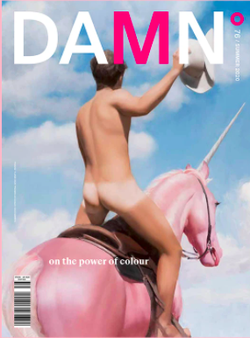
Article published on DAMN magazine about the research of the biolab. How sustainable is the colour dye in your top? Where did it come from and how long will its hue last in the wash before inevitably fading? We pick out colours for their shades and aesthetics, but it seems rare that we choose colours based on their pigment origins.
Las cosas
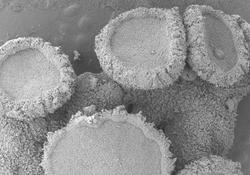
Las Cosas is a collection of objects and images created to commemorate the centenary of the birth of César Manrique. Through it the artists do a revision of his artistic work from a contemporary perspective. The exhibition revolves around recognisable aspects of Manrique´s work, such as the relationship with the landscape or the vernacular architecture of Lanzarote, but also around other social, spatial and material aspects which result less tangible. Microscopic images and videos were created in collaboration with the group Evolution And Optics Of Nanostructures, (University of Ghent), School of Arts KASK (Hogent).
{: .credit} Carlos Álvarez and Saray Ossorio El Aljibe de Haría – Haría, Lanzarote Opening 18.04.202
KLEUREYCK Van Eyck’s Colours in Design
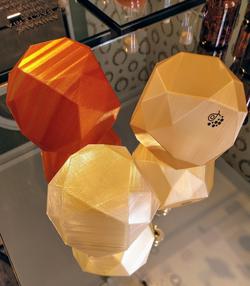
What is the origin of colour? How do you create colour? What is the impact of colour? In honour of the Year of Van Eyck in Ghent, the museum is hosting a large exhibition on the innovative and diverse use of colour. The exhibition starts from the unprecedented hues of Jan van Eyck and illustrates the significance of colour to contemporary designers. An exhibition about the innovative use of colour, linking the past and present with each other. The Color Biolab is part of one of the experience rooms, presenting the research together with the work of Pepa Ivanova and Tim Theo Deceuninck. Experience rooms let you perceive, taste and hear colour.
{: .credit} The exhibition is a coproduction with lille3000 as part of Lille Métropole 2020 World Design Capital.Colors, etc. is on display in Tripostal 09.10.2020 — 03.01.2021.Curator: Siegrid Demyttenaere together with Sofie Lachaert [pigment walk].
Internationale Vrouwendag 2020 in the meubelfabriek

Wat zijn je favoriete kleuren? We hebben het over de oorsprong van de natuurlijke kleurstoffen. We helpen jou om je eigen kleuren te maken en tonen dat ‘kleuren samenstellen’ een professionele bezigheid is.
Tech Day 20:Biotech & Future Sustainable Societies

This year's Tech Day lecture series, under the title "Biotech and Future Sustainable Societies", aims to highlight engineering in design, biology and science fiction as part of the creative process to envision and propose respectful and sustainable future societies.
The series proposes a reflection on the relationship between biomaterials and humans, in view of the future role of biological systems that generate new ecological materials. The aim is to investigate, understand and explore biomaterials in order to propose new futures in which objects come to life and are naturally integrated into human beings. The vision and responsibility that we have as design engineers should allow us to propose a logical discourse from the knowledge that is contained in biology, bioengineering, materials science and biodata.
Laboratorium presented “The Color Biolab: a transdisciplinary research on color”
W’re Out Phishin’ - Tools for Things and Ideas
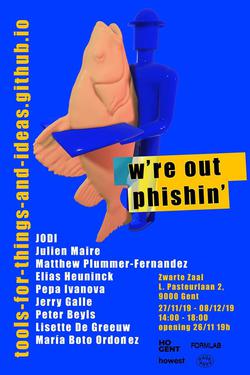
W’re out Phishin’ toont een verzameling van kunstenaars, biologen en makers die zich toeleggen op het verrijken van het publieke domein door onderzoek en ontwikkeling van 3D-technologieën en media.
Met: JODI, Julien Maire, Matthew Plummer-Fernandez, Elias Heuninck, Pepa Ivanova, Jerry Galle, Peter Beyls, Lisette De Greeuw, María Boto Ordoñez
Het onderzoeksproject Tools for Things and Ideas wordt gefinancierd door het Onderzoeksfonds Kunsten van HOGENT.
Opening: 26.11.19 - 19:00 Tentoonstelling: 27.11 - 08.12.19 Openingsuren: 14:00 - 18:00 Louis Pasteurlaan 2, 9000 Gent.
Project week 2019: Workshop screen printing with microalgae

Workshop "Screen printing with microalgae" at the textile department of KASK School of Arts in collaboration with Laboratorium.
Mushroom workshop at LUCA

Workshop on growing mushrooms at LUCA Schools of Arts organised by Pepa Ivanova.
Laboratorium at Onrust magazine
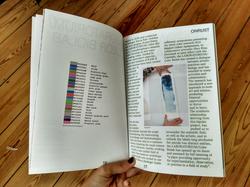
Text made by Bert Puype & Alice Lefebvre about Laboratorium and the Color biolab research project.
DDW @Albert Van Abbehuis "MAKE THE FUTURE"
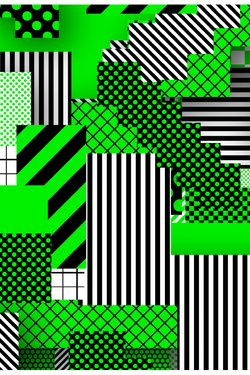
MAKE THE FUTURE is welcoming the curious, the open-minded, the extraordinary and the autonomous. Discover a range of exhibits, talks, performances and more during Dutch Design Week. In the group exhibition MAKE THE FUTURE we lay hold of the archetypes and how we play with expectations and identity without tapping into new sources. The designers, researchers and artists open up everything that really matters and start moving into neoteric realities to find new roads to cultivation. How important is design if we already have too much? How many chairs can one own? Can we re-use ideas? How can we learn to (re-)assemble? How do you reverse the process of the makers industrialization? Should we discuss the process of the maker-mind? Will we develop greater clarity about what should be? Will artists play a more important role in understanding context and the nature of change? Will thinkers and makers merge or continue down separate paths? Will design sustain? Let us use disruptive power to change awareness and acting. We play to see, understand and act.
In the Albert van abbehuis the lab presents the website “neochromologism.io” together with the pigments from microalgae and bacteria and their application in a printed publication or 3D printer filament together with the works of Sina Hensel and ELias Heuninck.
DDW @Plan B "Forget me Not"
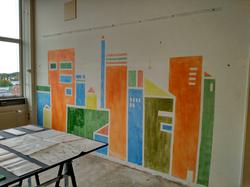
‘We are born (originate), we live (exist), we die (decompose)’ A search into our desire to preserve what is. We know life comes to an end, yet there is the desire for eternity. Rhythms of nature, of life, take us along babbling brooks, through storms, across mountains, down our own path. Everything we discover and experience along the way is kept in our memories, they are unique and are hidden in our hearts. Deep down inside, lies a desire to stop these memories of becoming a memory. It is our wish to preserve them and keep them forever. Suppose this was possible. What if we could capture everything in a glass cage, lock it up and believe we could preserve it all. This series of prints is made with natural pigments of algae, they decompose by daylight. If you want to preserve them, you will have to protect them from daylight and keep them in the black box. They will not see the light of day. Therefore, if you want the prints to see daylight, you will have to accept the consequences.
They originate, they exist, but will they ever decompose? This is a question we can ask ourselves in relation to the more and more feasible world that we are creating ourselves. This project is the result of an artistic research conducted by Studio Kars + Boom, supported by the scientific research of School of Arts Ghent.
At Plan B the lab is presented as part of a collaboration with the illustrators “Kars en Boom” and their project “Forget me not”. For that they painted one of the rooms with the pigments from the color research.
Hack The Lab

The Open BioLab Brussels and Laboratorium are two biological laboratories respectively located in a scientific (biomedical laboratory sciences) and artistic education institution, with a particular focus on transdisciplinary education by offering the students new tools and methodologies.
October 3rd LOCATION Zwarte Zaal, KASK, Campus Bijloke, 9000 Ghent 15h: Guided tour by present artist to the Art-Science exhibition "Seeing together: A Synopsis”. Artists: Annemarie Maes, Peter Beyls, Jerry Galle, Sina Hensel, Pepa Ivanova, Vanessa Müller, Elias Heuninck, Zeger Reyers, María Boto, Kristel Peters.
October 4th LOCATION Erasmushogeschool, Laarbeeklaan 121, 1090 Jette, Brussels 7.20 meet at Gent Sint Pieters 9h: Opening doors 9h20: Welcoming (Tom Peeters- Erasmushogeschool, Maria Boto-KASK, Hogent) 9h30: BioArtist Annemarie Maes (België): "Sensorial Skin: researching bacterial (bio)sensors" 10h15: BioHacker Channel Thomas (Denemarken) aka Little Pinkmaker: “sustainable biomaterials” 11h: Break 11h15: BioHacker Andreas Stuermer (Oostenrijk): "Biology beyond borders" 12h: BioArtist Christina Stadlbauer (Finland): "Ceramic Scar Tissue, an exploration of Kin Tsugi with life matter in the microbiology" 12h45: Lunch 13h30: Workshop
Workshop Channel Thomas This hands-on workshop will give you the skills and knowledge to create your own array of vegan cheeses, milks, creamy spreads and dairy-free desserts. Limitless options for flavours and styles, a great way to impress yourself, your family and your friends.
Workshop Andreas Stuermer 2 million dollars for a syringe? Zolgensma is a gene therapy that is used to treat spinal muscular atrophy. In this workshop we learn how to design DNA with the SMN1 gene as an example, talk about Gene therapies, regulatory hurdles, patents, and the ethics of commercial and potential DIY treatments. This event is made possible with the financial support of the EhB-HOGENT Alliantiefonds
Seeing together: a Synopsis
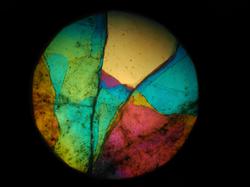
Often asepticised, secluded and reserved for scientific purposes, a laboratory is a place for scrutiny. Seemingly opposed to the immaculate space of scientific research, is the artist’s studio. Expected to reflect on creativity, the studio tends to be subject to preconceptions. For two types of creativity, two separate shelters. Nonetheless, scientists as well as artists seek « a place providing opportunity for experimentation, observation, or practice in a field of study ».
This exhibition celebrates the research of the Color biolab, offering a transdisciplinary approach to both art and science. The presence of a biolab in an art school, produces bilateral opportunities to thrive and to learn. The symbiotic relationship deriving from this bipolar project, forces one to reconsider and rethink the labels attributed, therefore making the partition between art and science more permeable.
In collaboration with María Boto Ordóñez and Kristel Peters from the LABORATORIUM/Color biolab. With the participation of Peter Beyls, Tim Theo Deceuninck, Sina Hensel, Elias Heuninck, Jerry Galle, Annemarie Maes, Vanessa Müller, Pepa Ivanova and others to be announced. Curated by: Alice Lefebvre and Bert Puype
Opening: 20 September, 2019, from 7pm Exhibition: 18 September – 6 October 019 Mo – Fri: 14:00 – 18:00 Sa – Su: 11:00 – 18:00
Zwarte Zaal – KASK Louis Pasteurlaan 9000 Gent
1m3: Interaction of Color
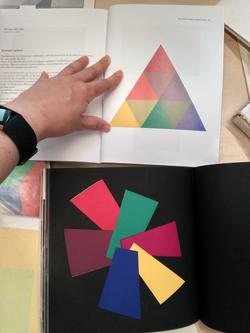
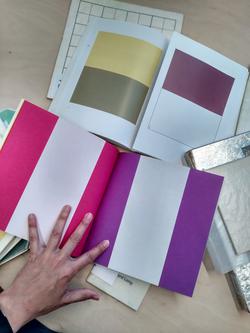
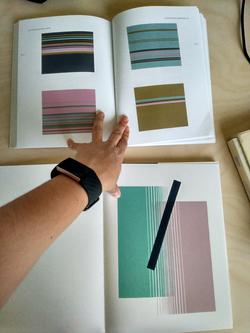

In the mid-20th century, Josef Albers revolutionised the art world with the publication of his book "Interaction of Color". Published for the first time in 1963 by Yale University Press, it contained a limited edition of 150 silkscreen plates, where Albers showed the relativity of colour.
Until that time, colour, a fundamental part of art education, had been limited to static systems of colour combinations. In disagreement with this approach, Albers questioned this immobility and the separation between the physical colour and perception by developing a series of exercises in collaboration with his students. During his lessons, they explored different aspects of colour behaviour by testing colour combinations, shapes, and techniques. These exercises are collected in "Interaction of Color", translating what was born as an experimental teaching tool, into one of the most used reference books in colour studies nowadays.
For 1m3 some of the silkscreen plates from the first edition are shown along with other artist books from the HoGent School of Art’s library collection. In these books, colour plays a leading role, and its forms and application remind us of the research developed by Josef Albers.
Color Biolab in Kunstletters
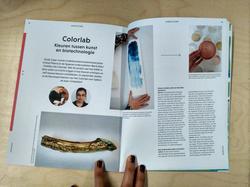

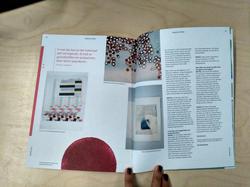
Publication of an interview about the color research project made by Olu Vandenbussche for Kunstletters.
Color Biolab Workshop: Harbinger Subtle Collisions:
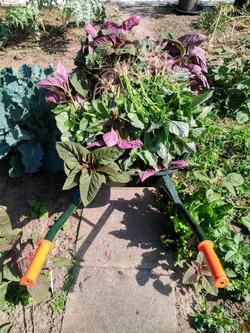
What is color? Chemistry? Light? Perception? Language?
During the Harbinger Subtle Collisions, the Color Biolab organizes a workshop in collaboration to Michael Tytgat (UGent) on the use of colors in quantum physics followed by a hands-on activity with three coloring plants that grow in the Ghent University Botanical Garden (madder, St John's-wort, and European indigo). During the workshop, colors will be extracted and applied in different mediums and formats: scientific publications, pigments, extracts, and dyes, will be used on glass, fabric, and paper. Thanks to Michael Tytgat (UGent), Ghent University Botanical Garden, Laurence de Craene (Industrie Museum) and Huis van Kina.
Harbinger: Subtle Collisions
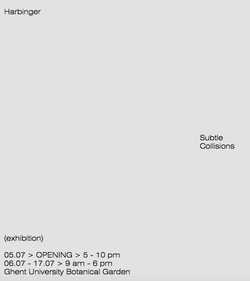
A HARBINGER is a forerunner. Historically linked to the idea of providing lodgments in advance, it indicates something or someone foreshadowing events in the future. In the context of the EPS-HEP conference to be held in Ghent this summer, KASK’s 2018 - 2019 Curatorial Studies designed this series of events drawing closer lines between art and science in partnership with art@CMS, a program developed under the CERN experiments in Geneva.
For this project, from LABORATORIUM we will work with the red, green, and blue pigments produced in the Ghent Botanical Garden in collaboration with the Dept. of Physics and Astronomy of Ghent University, as an exercise of translation between different scales and fields. This project intends to be a space of freedom to reflect on the use of common terminology and the possibilities of generating new knowledge by combining both fields.
Workshop: Verven met natuurlijke indigo
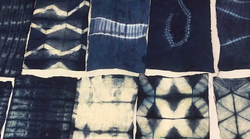
Trio Tinctorius, dat zijn drie mensen die vegetaal verven: ze halen kleur uit de natuur en gebruiken dit als verfstof. Tijdens hun eerste workshop op 15 juni, gebruik je uitsluitend natuurlijke en ecologische producten om een indigovat aan te maken.
Je krijgt eerst een theoretische inleiding door Maria Boto van het colorlab KASK, en daarna zal je samen met Laurence textiel verven met indigobaden. Trio Tinctorius werkt met Japanse shiboritexhniek (tye en dye). Breng gerust zelf een (kleding)stuk mee dat uit natuurlijke vezels (katoen, linnen, zijde,...) bestaat, en dat je graag wil pimpen!
prijs — 40 euro materiaal inbegrepen en geen voorkennis nodig maximum 8 personen inschrijven via ferdinance.crane@gmail.com
Nieuw kleur DOK
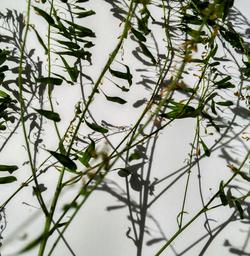
Zondag, 2 juni, stellen ze trouwens het atelier open voor publiek en geven ze een demo over hoe je een tweedehands kledingstuk in een nieuw kleur verft met plantenmateriaal!
ICA-Belgium COLOUR SYMPOSIUM

The Colour Symposium brings together Belgian and international speakers from various disciplines spanning the fields of art, design, science and technology. A 3-day event encompasses two days of presentations, interactive color exploration, a tour of the Light & Lighting Laboratory and its latest research, film screening and a full day workshop on color education.
Presentations cover the latest color research and application in areas such as art, design, architectural and spatial design, lighting design, film, science and technology, color education and psychology.
LABORATORIUM will be present during the ICA-Belgium Colour Symposium together with other professionals of the color field.
Picture done with yearofcolour application
ETHO Conference, Aalto University
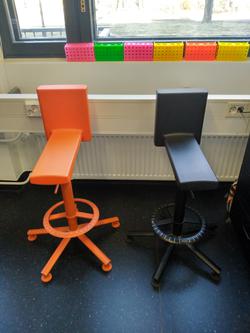
The third Art and Design Academies Technical Service Workshop was organised by Aalto University in Espoo at 4 and 5 April 2019. Together with Elias Heuninck, Formlab and Laboratorium were presented at the conference.
The conference is held by and for workshop masters and heads of technical staff. Besides attending lectures, we went on a tour of the workshops in Aalto’s new Väre building. The sessions were an excellent opportunity to learn, benchmark and raise questions about the changing roles of the workshop, the workshop master and the students working there.
RessObject in Kanal-Pompidou Brussels
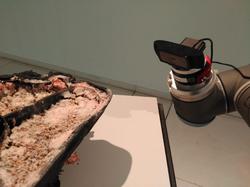
RessObject will be exhibited by Gluon in Printemps Numérique, a 2-day festival for digital culture initiated by the Brussels Government at museum Kanal - Centre Pompidou in Brussels from 22 until 24 March 2019.
In this work of the artist Jerry Galle, mycelium is growing inside of a PLA sculpture printed by FORMLAB. The deformation is captured by a camera attached to a robot arm and recognized by an AI program.
LEVEND TEXTIEL: printen met algen
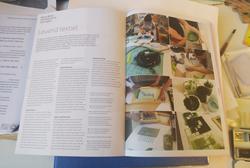
Article in the magazine TxP (Magazine over Textilekunst) over one of our workshops on microalgae textile printing written by Manelprints.
Bright up the chameleon skin to pale
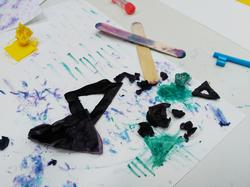
Bright up the chameleon skin to pale Performative experiments of Pepa Ivanova during the Master Seminar.
A discussion of the abiotic condition of light and its manifestation in color appearance, time and transformation. In order to embody that transformation, we will imagine ourselves being in continues mutation where rainbow colors can invade our skin and plastic starts grow out of us into a new set of nature. While our skin becomes a color laboratory I will tell stories of my artistic evolution into numbers/ time/ patterns/ soundscapes/light intensities collector and lover... and currently a PhD researcher.
Skin is a garment. Cosmetics comes from Cosmos.
Master seminar Art Science and Technology Interactions 2019
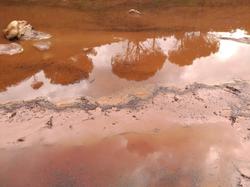
In this third edition of the Master Seminar Art, science and technology interactions participants will have an introduction about bioart, synbio, technology and pop, together with a wide number of scientific experiments performed in the lab.
The guest speakers were Pepa Ivanova, Tom Peeters and Kristel Peters.
TFG dyeing with live bacteria
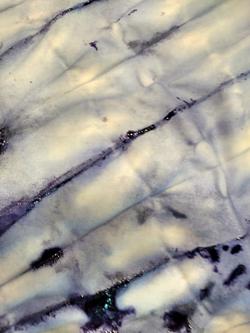
On February 6th we organized a workshop with bachelor students at ELISAVA on dyeing with living bacteria.
Master in Design through New Materials
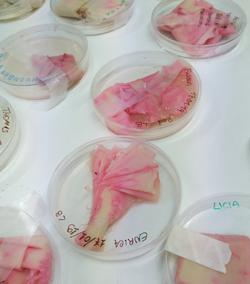
During this course, the participants will have an introduction to the use of biomaterials, specifically pigments derived from microorganisms. From the current design context to practical work with microalgae and bacteria (methods, applications…), this course aims to show not only how biotechnology provides tools, materials and methodologies that can be used in design/artistic creations, but also the implications and questions generated during a transdisciplinary research.
January 17th and 18th. February 5th.
FARO

We will be at Ter Vesten cultural center in Beveren the 17th of November presenting FARO, an experimental movie based on the Belousov-Zhabotinsky reaction. A work made in collaboration with Elias Heuninck.
Fibre-fixed

We will participate in the exhibition Fibre-Fixed at the Design Museum in Ghent together with FORMLAB and the artist Jerry Galle with a 3D-organic shape that grows monitorised by a AI system.
From 26.10.2018 to 21.04.2019
Du pourpre à la pourpre colloquium
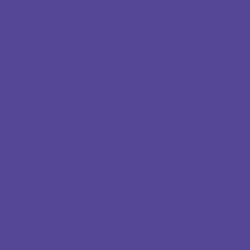
On October 13th and 14th in Brussels, a colloquium about the color purple will be carried out by Nuances de Plantes. Historians and makers will reflect about the meaning of the color and the origin (murex). Laboratorium will present alternative purples derived from bacteria and algae.
In parallel, there is a collective exhibition of works made in purple obtained from plants and animals pigments.
Screen printing with algae and plants at Ghent Industrie Museum
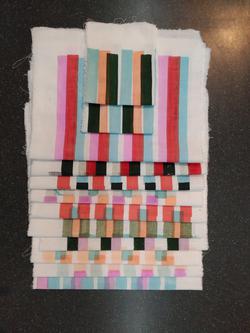
In collaboration with the Museum of Industry in Ghent, we will screen print with algae and plants used in the color research during the museum opening festival. The demonstration will be the 29th and 30th of September from 15h to 17h.
Mar Menor Lab: Art+Science in an emergency landscape
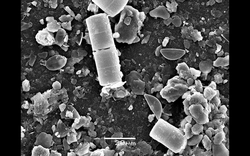
From 09-11-2018 to 09-16-2018 in Mar Menor, Murcia (Spain), we will participate in the summer school about art and ecology, Mar Menor Lab: Art+Science in an emergency landscape with the project "Land of Diatoms" together with Susana Cámara Leret. During this summer school, "Land of Diatoms" proposes the creation of a mobile lab, addressing the reconfigurations of the territory through the migrations of live diatoms in the Mar Menor.
Grow your own spirulina algae!
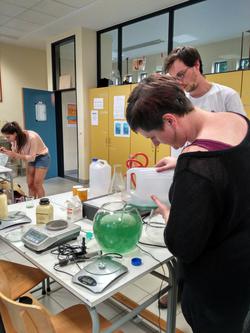
First session in collaboration with ReaGent about how to grow spirulina at home: from the starter culture to the final product. On June 6th at 19h.
Second session: Algae application on fabric. On June 20th at 19h.
Location: ReaGent (Wispelbergstraat 2 9000 Gent)
Wood Fungi Conference
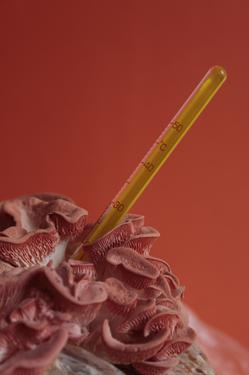
As part of the collaboration with Mycelia and Zeger Reyers, we will present the results of The Colours of the Oyster Mushroom workshop during the Wood Fungi Conference celebrated in Handelsbeurs, Ghent.
June 3rd-6th.
Workshop Hack the Pigment // Spirulina Session
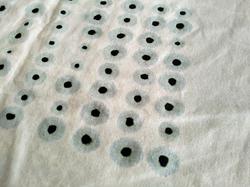
Het Werkhuis, in collaboration with Laboratorium and Wabi.labo, organizes a workshop on Spirulina (cyanobacterium Arthrospira). Spirulina is not only a food supplement but a rich source of natural colors such as carotenes (orange), chlorophyll (green) and phycocyanins (blue). In this workshop, you will learn how to grow spirulina at home and use it as a pigment for textile printing. By controlling the degradation of the pigment, you can have a wide range of blue and green colors that will change on your fabric over time. Together we will look for the possibilities in different printing techniques, and you will go home with your own creation and the necessary knowledge for carrying on your own experimentation. "Hack the pigment sessions" is an open source study of the use, creation and formal application of colors.
Gent aan Zee

During the climate festival 'Gent aan Zee', Laboratorium presented its research on sustainable materials through the construction of a beach setting. Visitors were able to sit in chairs printed with algae, wear mushroom flip-flops, embroidery bacterial leather and use their creativity for painting with sustainable pigments a parasol. Gent aan Zee is a climate festival in the Bijloke where organizations, individuals and companies show initiatives developed in Ghent to combat the climate change by proposing sustainable alternatives to daily life activities.
Future Materials
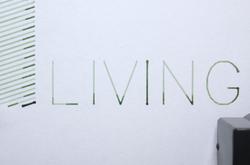
A poster printed with algae ink was presented in the exhibition Future Materials organized by Handmade in Bruges. The poster was made by using inks derived from the Color Biolab research project and designed and printed by Open Source Publishing. This exhibition shows the possibilities of using bio-based innovative sustainable materials by craftsmen: experimentation and application.
Opendeurdag KASK 2018
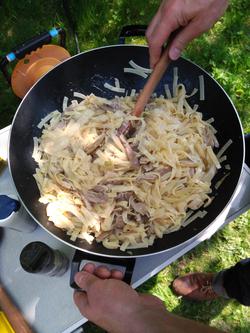
During the school Opendeur dag in the greenhouse located in one of the gardens of KASK the results The Colours of the OYSTER MUSHROOM workshop were presented: How to grow oyster mushrooms step by step, how to cook them or use them as an artistic artefact. Growing brushes, newspapers, jackets or chairs were full of delicious mushrooms that were tasted following the "Fennel- Oyster mushroom pasta By Pien & Zeger Reyers" recipe.
Projectweek 2018: Algae print
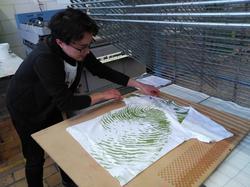
A group of students from the fashion department designed five iconic fashion motives to be printed with algae: animal, cashmere, flowers and pied de poule. The green-blue print derived from the algae was later applied in fabric, paper, and second-hand clothes.
Colour Day Conference 2018
For the Belgian International Colour day in La Cambre, Brussel, we had the opportunity to present our work (The Color Biolab: transdisciplinary research on color) and discuss with other color professionals on topics as color psychology or color biology.
Project week 2018: The Colours of the Oyster Mushroom
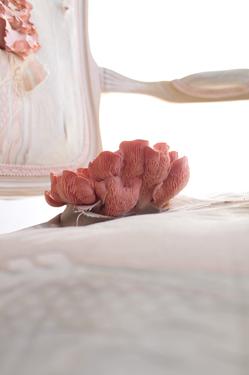
The experimental bio lab for art and design LABORATORIUM offered a workshop about oyster mushrooms. We focused on the life cycle of the oyster mushroom where waste becomes food. Meanwhile, different disciplines were touched: from biology, landscape architecture, economics, installation building, documenting colors, to the art of cooking. Oysters are one of the most versatile mushrooms and very edible. They are easy to cultivate and common all over the world. Oyster mushrooms can be beneficial to the body and break down toxic chemicals. They are also stunning and grow in a broad spectrum of colors. By starting to grow them on several objects, we were taught and led by artist and mushroom expert Zeger Reyers (NL) and the KASK LABORATORIUM to transform different objects in a substrate for this organism.
Experimenteel Zeefdrukken Met Algenverf
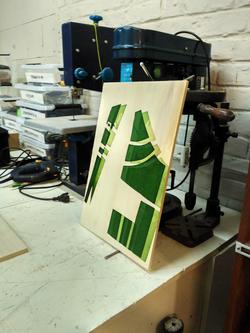
Twelve participants between 12 and 18 years old experimented with spirulina and screen printing in the Batterie. After an introduction about algae, algae pigments and how to grow them at home, participants made screen printing in wood by using spirulina.The printing patterns were a selection of participant's special points in google maps, and the green shades were obtained by mixing spirulina with the screen printing binding product.
This workshop was organised by Handmade in Brugge in collaboration De Batterie and LABORATORIUM
Master seminar Art Science and Technology Interactions 2018
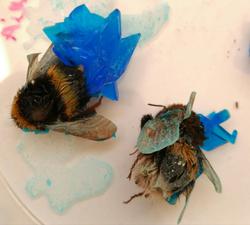
In this second edition of the Master Seminar Art, science and technology interactions participants had an introduction about bioart, biodesign and the role of science in our daily culture, together with a wide number of scientific experiments performed in the lab. Living organisms as yeasts, bacteria, algae and protozoa, chemical reactions as B-Z reaction or crystallization processes are part of this seminar that pretends to show and reflect on the possibilities of new materials and methodologies in art and design practice.
The guest speakers were Zeger Reyers, Bram Crevits and Kristel Peters.
Prepositions in Artistic research Symposium
For the conference Prepositions in Artistic research, organized by Arts Platform Brussels and ARTO, Laboratorium presented LABORATORIUM: experimental biolab for Art-Science research. Art-Science projects are becoming more and more popular. Scientific institutions are inviting artists to participate in their research, offering space, expertise and equipment. But what about performing scientific research within an artistic context as an art academy? What kind of cross-pollination will be the outcome? In this conference, we questioned the methodology followed, the knowledge generated, as well as the language and context to present and communicate the results in transdisciplinary research.
WoooW Festival
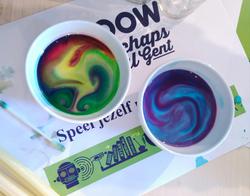
LABORATORIUM participated in the science week 2017 with a workshop on color in MIAT. In this workshop pH, density, surface tension, capillarity and other scientific concepts were explained while doing colorful experiments with a group of young scientists/artists.
Belgian Society for Microbiology Conference
Belgian Society for Microbiology Conference
We present the results of our collaboration with the Center for Microbial Ecology and Technology (CMET), Ghent, Belgium in the Anual Conference of Belgian Society for Microbiology. Inspiring photographs, colorful bacterial drawings and original designed lab-tools were obtained as outcome, reflecting on the limit between both disciplines, the aesthetic of science and the use of living organism for artistic proposes. This project aimed to establish a dialogue between art-science, questioning traditional parameters of scientific and artistic production and opening new approaches to academic research to improve, optimize and extend the outreach activities in both areas of knowledge.
Traditional dyeing
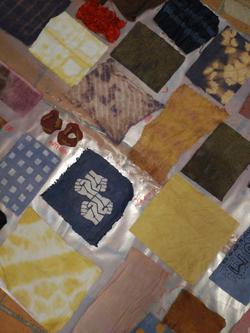
In collaboration with the fashion department from KASK, we did an introduction course on natural dyeing by using madder, weld, cochineal, logwood, buckthorn bark, and alkanet. A wide range of red, yellow, blue, purple and green colors was obtained as result of different dyeing materials in combination with different mordants.
X-Ray: Laboratorium @KASK
- Thursday 18 May 2017 at 20h30
- Friday 19 May 2017 at 20h30
- Saturday 20 May 2017 at 20h30
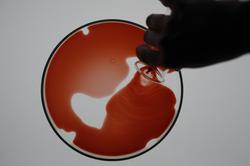
X-Ray: Laboratorium explores the boundaries between art and science by presenting a group of short films where the filmmakers have entered in the laboratory looking for inspiration, tools and methodologies. Full of intriguing images, between the natural and the artificial, the organic and the inorganic, X-Ray: Laboratorium ranges from chemical reactions to space research.
X-Ray: Laboratorium is compiled by Joost Rekveld and is organized in collaboration with LABORATORIUM, the experimental lab for art/design and biotechnology at Atelier Mediakunst, KASK School of Arts Ghent.
Master Seminar: Art, science and technology interactions 2017
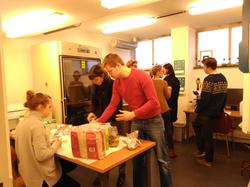
In the past few decades, there is a growing number of art, science and technology collaborations. This seminar offered the possibility to explore the interactions between these fields and places this contemporary phenomenon within a larger cultural, historical and political context.
KASK’s recently installed experimental bio-lab for art and design ‘Laboratorium’ functioned as the concrete starting point for the seminar, led by Bram Crevits (Media Art) and María Boto (Science).
Not only the emerging biotechnology has provided tools, materials and methodologies to artistic creations, but also this intersection generates questions and discussions that traditionally have been limited to the scientific community. On the other hand, new approaches to a particular topic could bring unexpected solutions or research lines that rarely would be obtained in traditional academic contexts. Collaborations between art and science engage explicitly in the fields of change of our socio-technical world. Both from a cultural or artistic approach and from a scientific or technology approach, it is a context requiring openness, challenging and expanding both the notion of art and of science.
The aim of this seminar was to give a general overview of art-science collaborations by presenting several examples, developing a critical approach to them, and exploring hands-on possibilities and challenges of the dialogue between science and artistic research.
Guest speakers: Paula Pin, Kristel Peters, Peter Beyls and Joost Rekveld.
Indigo workshop

Together with the researcher Clara Vankerschaver, from the textile department, a workshop about indigo has been organized. Moving from the chemistry behind indigo color to a practical experience with several fabrics, the participants will create beautiful blue hues.
Vlaamse Wetenschapsweek in KASK
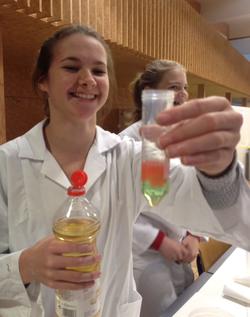
For the first time, the School of Arts KASK participated in the Vlaamse Wetenschapsweek with a workshop ran by two researchers from the school, Kristel Peters and María Boto. The workshop was split into two parts: the first part was focused on the mycelium, where the students were able to create their own mycelium sculpture, followed by the second part where color was used to explain several scientific concepts by creating ephemeral art pieces. Eight participants from Koninklijk Atheneum Voskenslaan experimented with biology, physics or chemistry, breaking the boundaries between art, design and science.
Colour and vision, Natural History Museum, London
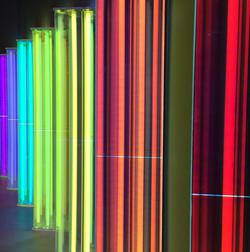
As part of the color research project developed in KASK, we had the opportunity to visit the exhibition “Colour and vision” at the Natural History Museum of London, and also to talk about colors with Dr. Suzanne Williams, a scientific researcher who helped design the exhibition content along with Dr Greg Edgecombe and Ms Fiona Cole-Hamilton.
We are surrounded by colours, and the gate to enjoy them is the eye. For that reason, the first part of the exhibition, after Liz West’s art installation, was focused on the evolution of the eye, that unavoidably goes in parallel to the increase of colors in nature. The evolution from light sensors to much more complex structures supposed an important change not only for the living organisms themselves but also for the environment.
An overview from the Precambrian Eon until now shows the evolution of eyes: first fossils, especially trilobites, and then a wide range of existing animals with different eye structures: arthropods, mollusks, cnidarians, onychophora and finally mammals.
The second part of the exhibition was dedicated to color in nature. What is color, where it can come from and how we perceive and interpret it. Visible and non-visible molecules. Derived from natural pigments, complex physical structures and the combination of both. Color stability and its importance in nature: colors to survive and to thrive.
Pigments are carotenoids, melanin, flavonoids, porphyrins, etc. They are found in vegetables like carrots, in animals such as flamingos and in our daily life products. However, there are some colors that the human eye can not perceive, as the fluoresce red of porphyrins under UV light in some mollusks.
There is a clear idea about the reason why some colors are present in nature, but not in every case. In the exhibition, the presence of colors in some animals is shown as a way of camouflaging, showing status, gender identification, facilitation of reproduction and feeding, light harvesting, etc. The color of an innocent ladybird warns us of the toxicity of its body, and marine iguanas use dark colors to store heat before going into cold water.
At the end of the exhibition, a video invites us to re-think our capability as humans to see, perceive and feel, by listening to the two scientists responsible for the exhibition -Dr. Suzanne Williams and Dr. Greg Edgecombe- and two artists, Liz West and Neil Harbisson, colorblind but able to hear colors through a camera implanted in his head.
